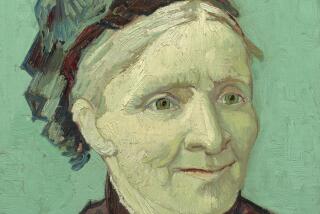WILSHIRE CENTER
- Share via
Highly touted as Ireland’s leading Expressionist painter, Patrick Graham works in a fragmented, almost diaristic style, confronting personal demons like a painterly Eugene O’Neill. “Expressionist” is a misleading label, however, largely because Graham’s often bitter war with himself is paralleled by a contempt for dogma ranging from religion to academicism and aesthetic theory.
This desire to exploit a painful personal history as a catalyst for “spiritual” redemption seems, ironically, to feed on Graham’s Catholic upbringing and early success as a prodigious draftsman at Dublin’s National College of Art. By rejecting the church and the stultifying academicism of “official” art, he proceeded through a series of personal crises that led to an exorcism of his past and a subsequent creative resurrection.
His recent mixed-media works on paper are loosely rendered “collages,” reminiscent at times of Francis Bacon’s anguished figuration and the self-mutilation of Arnulf Rainer. Self-portraits, references to his parents and children, scrawled texts, snapshots of himself or past artworks are arranged in loose hierarchies, resembling either religious icons or pages from a schoolboy’s scrapbook. Each image or phrase seems to be fleeting--literally or symbolically smeared, erased or superseded by a metaphor of equal weight, so that the viewer is left in a state of perpetual visual and semantic flux. As a result, these are often difficult works to grasp or rationalize, leaving us the simple experience of the visceral performance itself--which is, of course, Graham’s exact objective. (Jack Rutberg Fine Arts, 357 N. La Brea Ave., to May 30.)
More to Read
The biggest entertainment stories
Get our big stories about Hollywood, film, television, music, arts, culture and more right in your inbox as soon as they publish.
You may occasionally receive promotional content from the Los Angeles Times.










